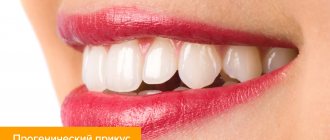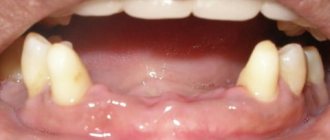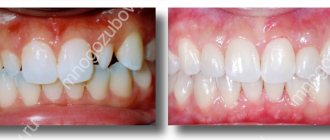Diagnosis: complete absence of teeth
Partial edentia means that the patient is missing several teeth. Multiple edentia is a condition in which more than 10 teeth are missing. If the patient has lost the entire dentition - on one or both jaws, then the doctor diagnoses “complete edentia”. As a rule, people in adulthood face this problem, but in exceptional cases, this diagnosis can occur in young people and even children.
There are two types of edentia.
- With primary adentia,
a person is born with dead/undeveloped tooth rudiments. Even partial primary adentia occurs in only 1% of cases of all dental anomalies, and complete primary adentia is an extremely rare diagnosis. The congenital absence of tooth buds is caused by various hereditary factors or diseases that provoke disturbances in the development of the dental plate. Thus, the cause of congenital adentia can be ichthyosis, hypothyroidism, pituitary dwarfism, and infectious diseases. - Secondary complete adentia
is most common in adulthood, affecting about 20% of people over 65 years of age. This form is considered acquired; it is provoked by:
- metabolic disorders;
- age-related changes;
- injuries to teeth and jaw;
- gum disease;
- caries and its complications.
Periodontitis, periodontal disease, periostitis, pulpitis, periodontitis without high-quality and timely treatment can lead to complete or partial adentia even at a young age.
Orthopedic treatment of complete edentia
In case of complete edentia, the doctor can offer two main correction options: implantation followed by prosthetics or wearing a complete removable denture.
Removable dentures were very popular before the advent of implant prosthetics, accessible to a wide range of people. Now removable dentures are used, but are not considered the optimal solution to the problem. In modern dentistry, several types of removable dentures are used:
✔
acrylic;
✔
nylon.
Acrylic removable dentures consist of a solid base and attached artificial teeth. The lack of flexibility gives these prostheses several special qualities, which are both the main advantage and the main disadvantage. On the one hand, a solid base contributes to an even, healthy load on the entire jaw when chewing food. However, this same property makes the prosthesis more fragile and less comfortable to wear compared to more elastic structures. Acrylic dentures have a porous structure on which bacteria and plaque accumulate; the monomer in their composition can cause an allergic reaction. When choosing this design, we recommend paying attention to Acry Free prostheses, made from the latest type of plastic without toxic substances. They are more modern, durable and flexible, but their cost is higher than other acrylic prostheses.
Nylon prostheses are more flexible and aesthetic. They are made from hypoallergenic materials. However, they have insufficient rigidity, which affects the quality of chewing food and contributes to rapid atrophy of bone tissue. Because of this, nylon dentures made of polyurethane and other materials are not recommended for use in completely toothless jaws.
What is the danger of losing chewing teeth?
If there is an end defect on at least one side (not to mention two at once), it will immediately become noticeable. When a person chews food on only one side for a long time, the load on it instantly increases, and the temporomandibular joint is overloaded. Ultimately this leads to:
- problems with chewing food;
- problems with the digestive tract arising from the previous paragraph;
- displacement of teeth in the oral cavity and their falling out of their sockets - there are no “antagonist” teeth that would distribute the load;
- reduction in bone tissue volume;
- facial asymmetry (sunken cheeks, deep nasolabial folds, malocclusion);
- frequent headaches;
- rapid wear of teeth adjacent to the chewing teeth, or chewing teeth on the opposite side.
Completely edentulous upper jaw
In case of partial absence of teeth, the prosthesis rests on the remaining units. If it is full, there is no such possibility of fastening, which may cause difficulties with the installation of the prosthesis. Therefore, dentures for the upper and lower jaws have significant design differences. Dentures for the upper jaw include a volumetric base that imitates the anatomy of the palate, which ensures a tight fit. To improve fixation, special gels are used. Dentures for the lower jaw do not require additional fastening elements, since they repeat its alveolar part.
Which prosthetics are better for complete edentia?
Classic removable dentures are affordable, but they are not able to provide everything necessary for a high quality of life:
- functionality;
- comfort to wear;
- quality of chewing food;
- healthy load on the jaw;
- restoration of the natural shape of the face.
This is a half-measure that does not allow us to fully restore a decent quality of life. This is why dental implantation is the best solution for complete edentia. Computer modeling methods allow you to understand what your smile and overall face will look like even before implants and prostheses are installed. At the same time, computer programs help to accurately determine the location of future implants to restore the natural shape of the face, eliminate deep wrinkles, hollow lips and cheeks caused by missing teeth.
In case of complete absence of teeth, two concepts of implantological treatment are provided: classical and mini-implantation.
With mini-implantation, which is considered a temporary solution, the prosthesis is installed immediately after implantation. With mini-implantation, only removable prosthetics are available, and the design is inferior to classical prosthetics in terms of reliability and durability.
In the classic version, the patient undergoes the procedure of engrafting several implants - artificial roots made of titanium, which will serve as support for the future prosthesis. To securely attach the prosthesis, a minimum of 4 implants are required in the upper jaw and 3 in the lower jaw. But in a number of clinical cases, to achieve better stability, it is recommended to use a larger number of implants. After 6 months, when the implants have finally taken root, a permanent prosthesis is installed on them.
Alexander Ovechkin
A puck flew into Alexander Ovechkin's face during a hockey match and left the Russian celebrity without a tooth. However, the athlete is in no hurry to undergo reconstruction. This is due to the recommendations of dentists, who warned that after installing an implant, a repeated incident on ice will injure the jawbone. And if you install a bridge, the neighboring teeth will also be under attack.
After weighing the arguments, Alexander came to the conclusion that it was not worth taking such risks. Therefore, in his free time, he wears an onlay, which saves space for further prosthetics, and he goes to the match with a hole in an even row of teeth. However, this did not affect his personal life and career.
View this post on Instagram
A post shared by Alexander Ovechkin (@aleksandrovechkinofficial) on Sep 14, 2022 at 2:54pm PDT
Features of treatment
Complete dentures on implants can be removable or conditionally removable. Removable ones are used for mini-implantation. Conditionally removable dentures are removed only in the dentist's office.
In classical prosthetics on implants, different fastening methods are used.
- Push-button fixation
is carried out using abutments - equatorial or spherical. When the prosthesis is fixed, the lock is activated. With some force, the prosthesis can be removed for inspection and hygiene procedures. - Another method is beam fixation.
First, a beam is made to connect the already installed implants. The prosthesis itself is attached to it. Prosthetics using this method are more reliable, but more expensive. From a technical point of view, it is more difficult to carry out.
Anti-aging dentistry: up to -15 years with the help of teeth
Author: orthopedic dentist Chesnokov Vladislav Anatolyevich
High-quality, thoughtful dental treatment allows you to restore not only health, but also youth and beauty. Let's look at examples of how this happens.
Teeth = youth and health
Rule No. 1 – teeth should always be there. On no matter how well-groomed a face, edentia, that is, the absence of teeth, will look helpless and painful. This is visible not only during a conversation or when you smile. Without teeth, the lips fall inward and almost completely disappear from the face.
We see the greatest rejuvenating effect when we install a prosthesis in a patient who is completely edentulous. Teeth appear, smile, cheeks no longer look sunken.
Example 1: I am rehabilitating this completely edentulous patient with removable dentures.
The load will save face
Chewing is a physical activity on the teeth and jawbone. Without constant work, the jawbone begins to atrophy and decrease in volume. What happens to the face at this moment?
- The chin moves forward and upward.
- The proportions of the lower third of the face change.
- Nasolabial folds and age-related sagging of the cheeks will become more noticeable.
- The depth of all horizontal wrinkles below the forehead will increase.
You've probably seen faces with this set of signs on the streets and thought that this is how aging manifests itself. Bone atrophy is premature aging, but it can be prevented by timely prosthetics and implantation.
The loss of one tooth will not be visible on the face at first, unless the tooth is in the smile area. But over time, neighboring teeth will become mobile, may shift and even require removal.
Keep in mind, “remove everything and put in nice teeth when you save money” is a bad option. Even a short six-month period without load leads to atrophy, and in the future this will make it difficult to fix the prosthesis. Costs for beauty will increase many times: for cosmetology and jawbone extensions. It is better to use installments or choose inexpensive options for removable dentures on teeth or with support on implants:
- Removable denture with ball-shaped fixation on implants,
- All-on-4, conditionally removable denture on 4 implants,
- Classic fixed prosthesis,
- Prosthesis with beam fixation.
Taking on new heights
Your dentist may suggest that you increase your bite height. Simply put, the length of the teeth.
With age, teeth naturally wear down against each other and become shorter. The bite can be raised using crowns or veneers, and in the absence of teeth, appropriate dentures can be made.
Example 2. A significant part of the teeth has been lost, the jawbone has degraded, and the shape of the face has changed. I treated with metal-ceramic crowns and simple acrylic dentures. Notice the thickness of the lips, the shape of the chin and the reduction of wrinkles.
What effect can be achieved by raising the bite:
- Wrinkles around the lips are reduced,
- Nasolabial folds are reduced,
- The oval of the face is corrected and becomes more elongated.
How much to raise: Your new teeth may even be a little longer than they were when you were young. This is fine. The doctor calculates the optimal bite height using special instruments, diagnostic results and phonetic tests.
20 shades of white
Over the years, teeth become darker and appear unhealthy, even if the dentist has no complaints about them. A bright smile is refreshing and rejuvenating. However, unnaturally white teeth are not suitable for people of elegant age.
- Too white teeth reveal the wearing of dentures.
- The whites of the eyes will appear yellow, which is a sign of fatigue.
- Skin may appear unhealthy and dull.
I recommend choosing light shades of the tone that you naturally have (reddish, yellow, gray pigment and combinations thereof). For example, the natural color of teeth is A3.5, but with prosthetics or whitening a smile is created in shade A2 on the Vita scale.
Take care of your teeth, treat them on time, and your smile will return your youth!
Orthopedic dentist Vladislav Anatolyevich Chesnokov is seen at CosmoStom on Mira, 29.
Bite with complete absence of teeth
With complete edentia, the jaw looks unaesthetic, and the shape of the patient’s face changes significantly. In this situation, specialists need to recreate the correct bite so that the prosthesis does not protrude or sink.
In order for the prosthesis to fit correctly, correcting aesthetic and functional problems caused by edentia, it is necessary:
- calculate the occlusal height of the upper jaw;
- form a prosthetic plane;
- determine the height of the lower facial region;
- determine the central relationship of the jaws and fix it with notches.
To determine central occlusion, the doctor holds the corners of the patient's mouth. After the patient swallows saliva, the jaws close correctly.










